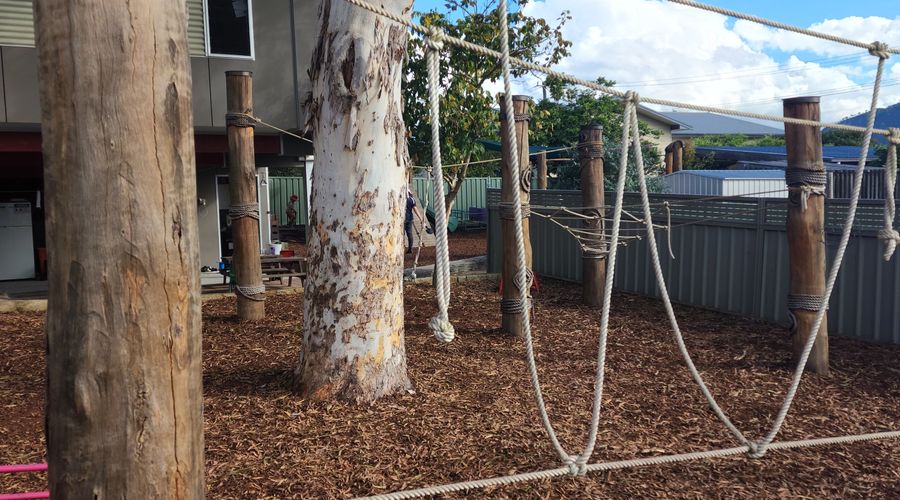From the moment you step outside into our unique outdoor learning environment, you will be transformed into a space that connects children to nature.
These areas were recognised for its natural design that support children’s development through play, exploration and risk management skills when it won the Kidsafe National Playspace Design Awards in 2018.
The outdoor environment consists of two areas, one designed for children under three years of age and the other for preschool age children. It is aesthetically pleasing with large natural grassed areas and a range of suitable spaces including garden beds, trees, vegetable gardens, composting, music & art pergolas, shade structures, paths, boat, mud kitchen, water pumping station, creek bed, bike track and much more.
Loose Parts Play is an integral part of our nature based curriculum. While it occurs in all areas of the program it is most prominent outside in the bark soft fall areas where the large timber poles can be seen. The poles provide the skeleton for supporting a creative way for children to play and learn. They provide an open ended landscape for engineering creativity.
The poles areas allow for positive adult-supported risk-taking play or challenging play and provides opportunities for self-assessment of risk. Research shows that children that engage in supported risky play can become better problem-solvers and in adulthood are more likely to take better, healthier appropriate risks.
Risky play helps to develop important life skill learnings, such as:
- Building resilience and persistence.
- Creative thinking
- Balance and coordination.
- Awareness of the capabilities and limits of their own bodies.
- The ability to assess and make judgement about risk.
- Handling tools safely and with purpose.
- Understanding consequence to action
All areas are nature-inspired spaces and are designed to provide children with open-end play possibilities, connecting them with our local flora and fauna.
Our service has a community sustainability practices ethos and this is embedded through all our programs. We have worm farms, compost stations, rainwater tanks supplying water to our children’s hand pumps, we upcycle and recycle materials and we frequently create and explore with natural materials.
In fact, we see the environment as the ‘third teacher’, alongside our highly trained, experienced early education professionals.

Outdoor Learning Environment Vision
To provide children with a natural outdoor learning environment that encourages self-exploration, and connection with nature. To allow nature to enrich the life of each child by supporting physical, social, emotional, and cognitive development.
Outdoor Learning Environment Philosophy
At Gloucester Pre School and Early Years Learning Centre we understand that children are naturally curious and have an unlimited potential for learning. Our spacious outdoor learning environments encourage children of all ages to interact with and manipulate the space, whilst stimulating and engaging their imagination and senses.
We strive to provide a beautiful natural outdoor space made from natural elements that supports biodiversity of our local flora and fauna. We believe our outdoor learning environment is designed for unhurried engagement that supports children's creativity, imagination, language and social skills.
Our outdoor environment should awaken the senses of those who engage within it promoting their health and wellbeing. This is promoted through natural shades of light, sounds, smell, taste and textures.
We believe that children of all ages should be supported to take risks and build resilience in a nature environment. The environment should be flexible so that the design can be modified to support children's natural learning, discovery, and self-design opportunities.
Through supported learning opportunities, conversations and observations children learn to appreciate nature, respect for the natural world and begin to understand the interconnectedness between humanity and nature.
Dr. Montessori wrote. “The land is where our roots are. Children must be taught to feel and live in harmony with the Earth."











